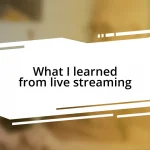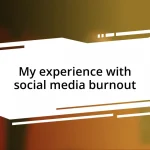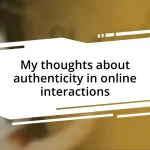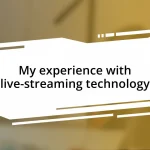Key takeaways:
- Embrace authenticity and vulnerability to connect with the audience, fostering a safe space for shared experiences.
- Develop effective communication skills, including active listening and clarity, to engage listeners and simplify complex topics.
- Recognize and build upon personal strengths, such as empathy and curiosity, to enhance relatability and content quality.
- Utilize improvisation techniques to respond spontaneously and turn mistakes into engaging moments that resonate with the audience.
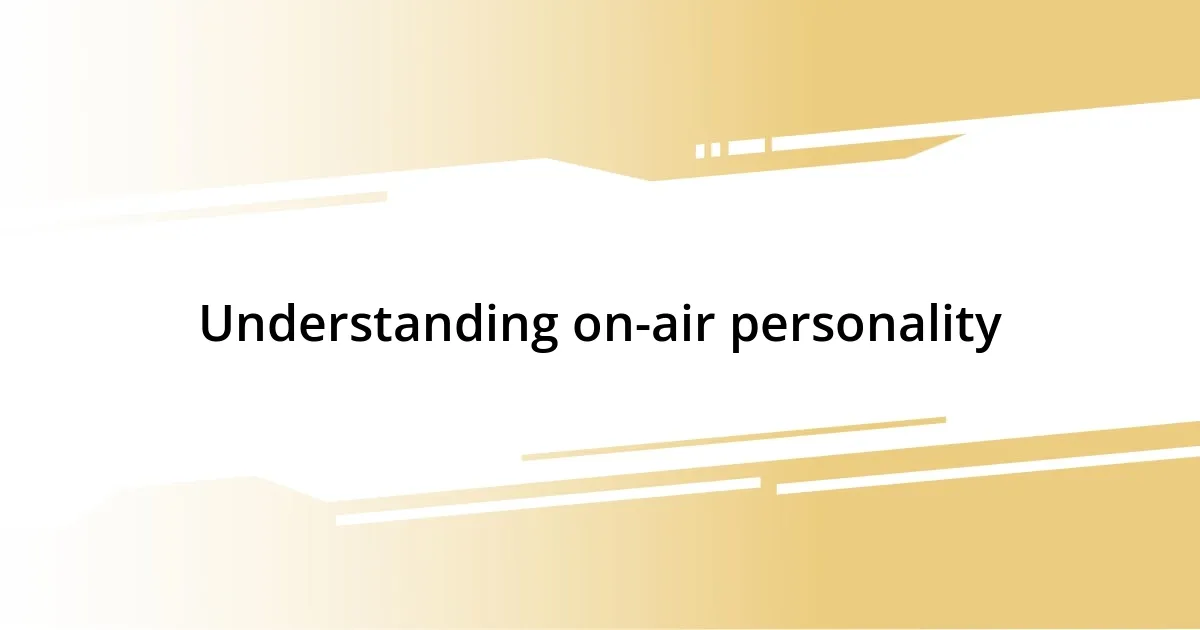
Understanding on-air personality
An on-air personality is more than just a voice; it embodies a unique blend of charisma, authenticity, and relatability. I remember my early days, feeling that rush every time I turned on the mic. It was exhilarating yet daunting. Could I really connect with listeners in a meaningful way? I learned that the answer lies in being true to oneself, allowing spontaneity and genuine emotions to shine through.
Understanding your audience is crucial in shaping your on-air persona. I often ask myself, “What makes my audience tick?” This insight has been invaluable. I recall an instance where I shared a personal story about overcoming stage fright. The response was overwhelming; listeners felt a connection and shared their own experiences. It reinforced the idea that vulnerability can be a powerful tool in building rapport.
Every on-air personality has a distinct style, influenced by their background and life experiences. I’ve experimented with different approaches, from humor to heartfelt discussions. Reflecting on these trials, I’ve realized that my best moments come when I blend my love for music with candid conversations about life. Isn’t it fascinating how our quirks and passions shape how we engage with the world?
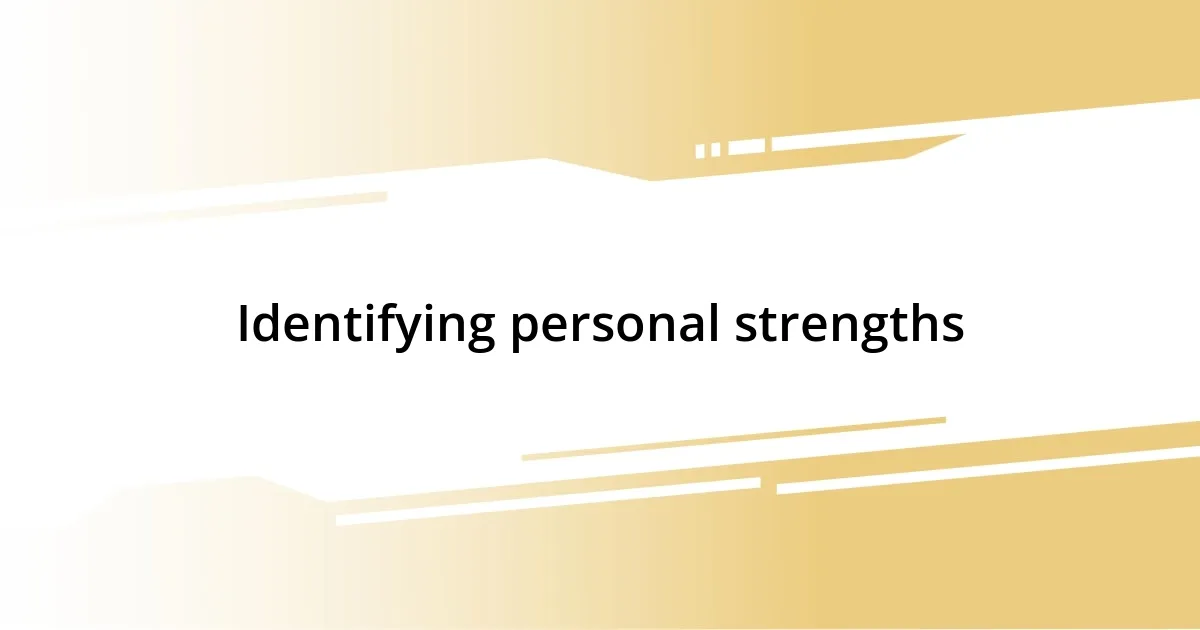
Identifying personal strengths
Identifying personal strengths is a crucial step in developing an authentic on-air personality. I recall sitting down one afternoon, pen in hand, and writing down my qualities. It was a revealing experience that helped me pinpoint what sets me apart. I discovered that my curiosity and empathy allowed me to connect with my audience genuinely. Recognizing these strengths not only boosted my confidence but also shaped the content I curated.
Here are some personal strengths to consider when self-reflecting:
- Empathy: Understanding listeners’ feelings and perspectives helps build a deeper connection.
- Adaptability: Being flexible in your approach allows you to respond to unforeseen circumstances on air.
- Storytelling: The ability to share personal anecdotes makes you relatable and engaging.
- Enthusiasm: A genuine passion for what you’re discussing can energize your audience.
- Curiosity: An inquisitive nature drives you to explore diverse topics, enriching your content.
Recognizing these strengths can turn a good on-air personality into a great one. I remember the first time I leaned into my curiosity during a live interview. I asked unexpected questions that led to an enlightening conversation. That moment taught me how my traits could transform a routine segment into something special, fostering a richer dialogue with my listeners.
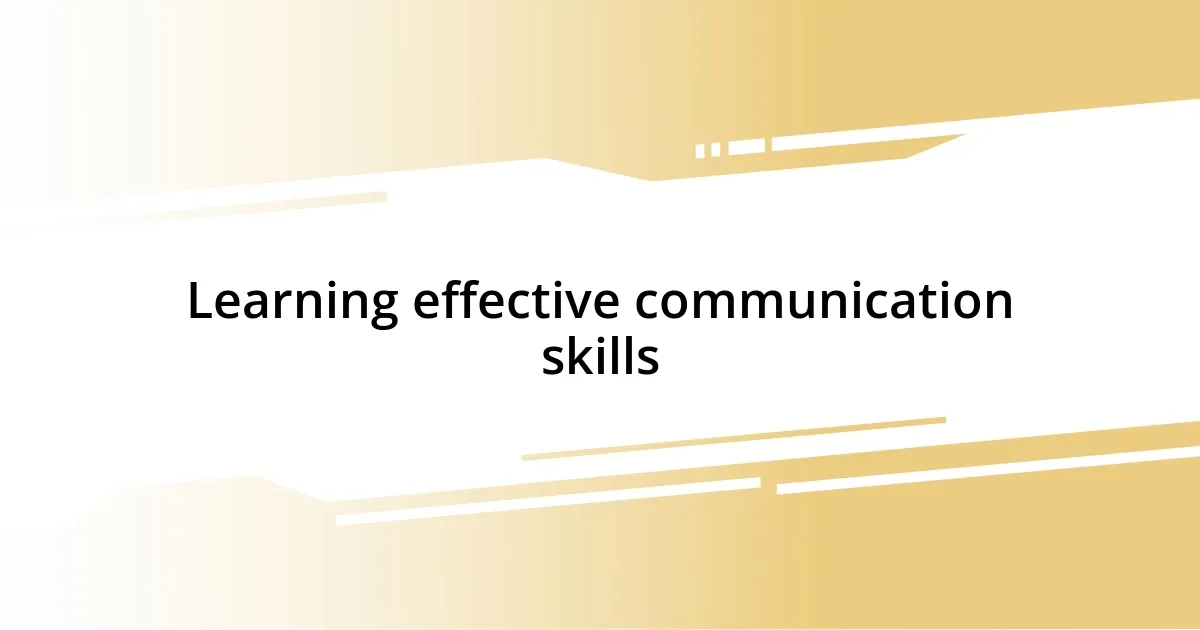
Learning effective communication skills
Learning how to communicate effectively has been one of the most transformative experiences in my journey as an on-air personality. I remember nervously stepping up to interview a local artist, feeling my heart race. It wasn’t just about asking questions; it was about creating an atmosphere where they felt comfortable sharing their story. I learned that active listening, where I focused entirely on what they were saying, allowed me to ask spontaneous follow-up questions. This not only made the interview flow naturally but also fostered deeper connections between us and with the audience.
As I honed my communication skills, I found that clarity is key, especially when addressing diverse audiences. One time, while explaining a complex topic about music genres, I simplified my language and used relatable examples from pop culture. I could see how my listeners tuned in; they appreciated my effort to break down barriers. This taught me that using accessible vocabulary and relatable references can bridge the gap between myself and my audience. The goal is to ensure they feel included in the conversation.
Moreover, non-verbal communication plays a crucial role in how messages are received. I remember forgetting to maintain eye contact during my early broadcasts, which diminished the connection I had with listeners. Now, I consciously portray enthusiasm and engage with my body language; I’ve noticed how this resonates with my audience. When I smile and show genuine interest, it’s like an invisible thread that draws listeners closer. Isn’t it fascinating how much impact our physical presence can have, even in a virtual space?
| Aspect | Description |
|---|---|
| Active Listening | Engaging fully with what the other person is saying, allowing for natural follow-up questions. |
| Clarity | Simplifying complex ideas to make them accessible to all listeners. |
| Non-Verbal Communication | Using body language and facial expressions to enhance connection with the audience. |
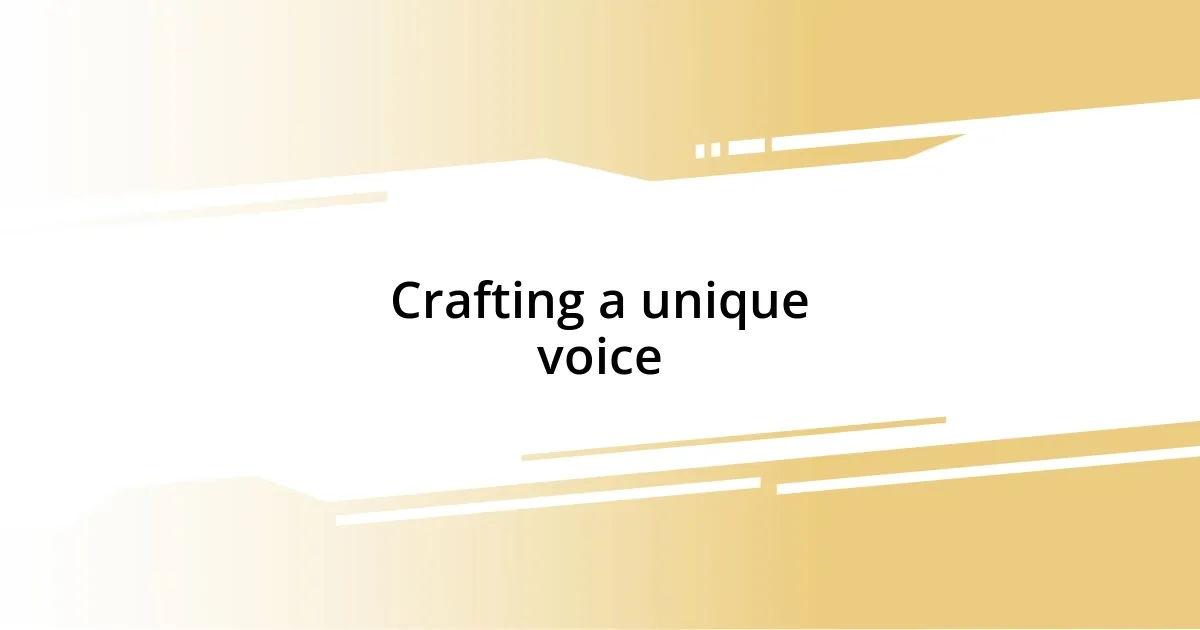
Crafting a unique voice
Crafting a unique voice is a journey, one that I vividly remember embarking upon. I once struggled to find a balance between who I was on air and the persona I felt the audience expected. By experimenting with different speaking styles and tones, I learned how to infuse my personality into my broadcasts. It was exhilarating to see the reaction when I embraced my quirks—my audience responded positively, as if they had finally caught a glimpse of the real me.
In my experience, authenticity resonates deeply with listeners. I recall a moment during a live show when I shared a personal story about a childhood mishap. It was unexpected, and honestly, it felt a bit vulnerable. But the feedback was astounding; people felt they could relate to my experiences. This taught me that vulnerability can foster connection. How often do we connect more with those who share their struggles rather than just their successes?
As I continued to refine my on-air voice, I discovered that incorporating humor and storytelling could transform the listening experience. One particularly memorable broadcast involved a lighthearted debate about a silly topic that I had almost dismissed. The laughter it incited drew listeners in like a magnet! It made me realize the importance of engaging content; a unique voice is not just about clarity but also about bringing joy and relatability to the conversation. Isn’t it fascinating how a little laughter can create a profound impact?
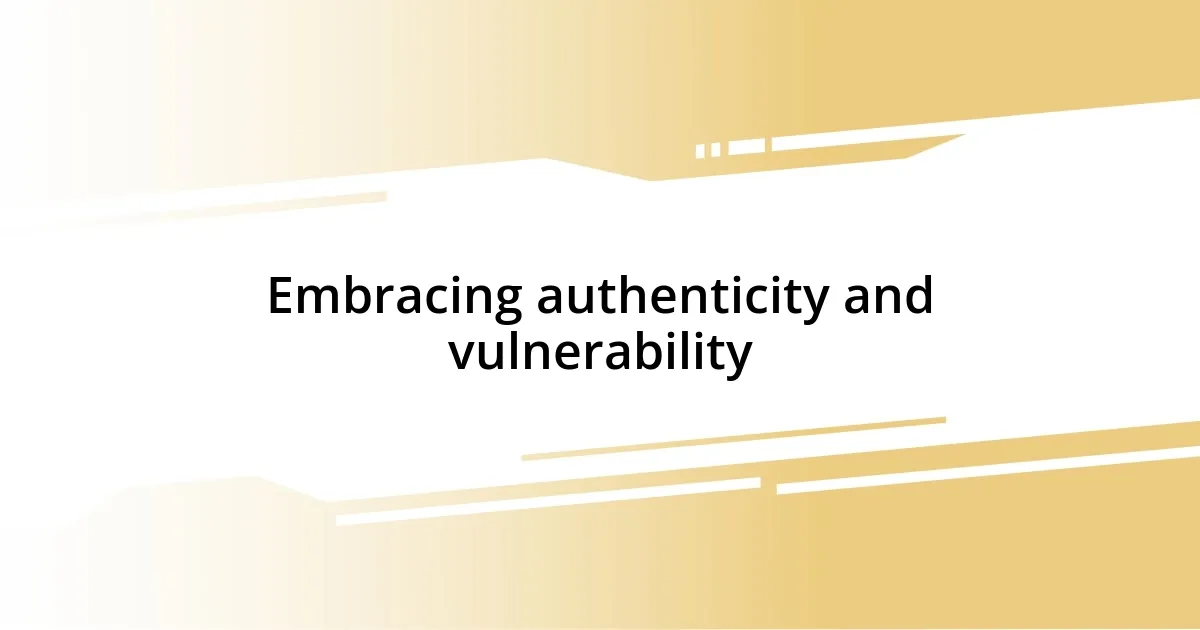
Embracing authenticity and vulnerability
Embracing authenticity and vulnerability has been a game-changer for me. I remember the first time I shared my struggle with self-doubt during a broadcast. Instead of receiving judgment, I was met with an outpouring of support from my listeners. It struck me that by revealing my imperfections, I created a safe space for others to be their true selves. Isn’t it liberating to realize that we’re all in this together, dealing with our own challenges?
I often find myself reminiscing about moments on air when I allowed my guard to drop completely. There was an episode where I spontaneously discussed the stress of preparing for an upcoming performance. That candid admission led to messages flooded with heartfelt stories from listeners who related to that anxiety. It reinforced my belief that vulnerability isn’t a weakness; it’s a bridge that connects us. How often do we shy away from showing our true selves, only to find that it’s our very authenticity that draws people in?
Incorporating my vulnerabilities into my broadcasts hasn’t just helped me connect with my audience; it has encouraged me to be more accepting of my own flaws. I recall a time I made a significant mistake live on air. Instead of brushing it off, I laughed about it and shared how I felt embarrassed. The kindness and lightheartedness that followed were incredible. It’s moments like these that remind me: embracing our authentic selves allows others the freedom to do the same. And isn’t that what we all seek? Authentic connections that celebrate our humanity?
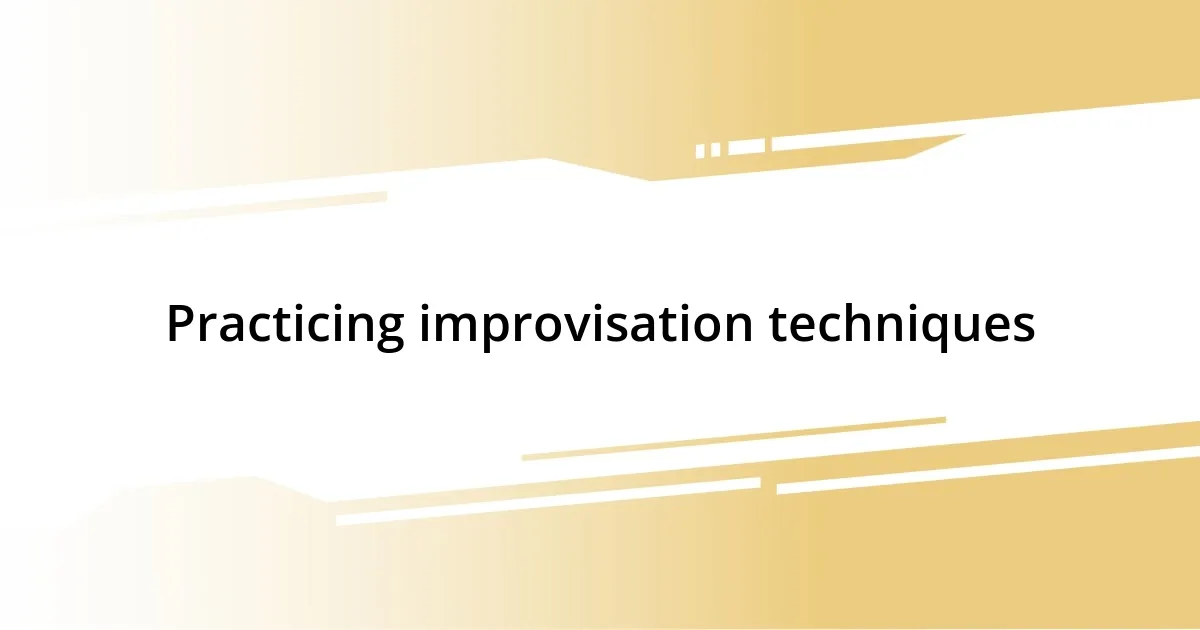
Practicing improvisation techniques
Practicing improvisation techniques has been an essential part of developing my on-air personality. I vividly remember attending a workshop on improvisational comedy, where the instructor emphasized the importance of thinking quickly on your feet. One exercise involved picking random words and immediately crafting a silly story around them. The laughter we shared not only helped reduce my nerves but also honed my ability to respond spontaneously during live broadcasts. Isn’t it intriguing how a few fun exercises can work wonders for your confidence?
Another memorable experience was during a live Q&A segment. A listener posed an unexpected question, and instead of stumbling through, I decided to riff off the moment and engage with my audience playfully. I remember thinking, “What would make this funny?” and the result was a hilarious back-and-forth that had everyone in stitches. This taught me that improvisation isn’t just about being clever; it’s about creating genuine connections in the moment. Do we sometimes underestimate our ability to entertain by simply being ourselves?
While practicing improvisation, I also learned valuable lessons about embracing mistakes. Once, during a live segment, I completely forgot a key point I wanted to discuss. Instead of panicking, I joked about it, saying something like, “Looks like my mind went on vacation without me!” The listeners responded with laughter and relatable stories of their own forgetful moments, reinforcing my belief that humor can turn an awkward situation into a shared experience. It made me wonder—how often do we allow ourselves to embrace the silliness in our flaws? That’s what keeps the conversation flowing and our audience engaged.
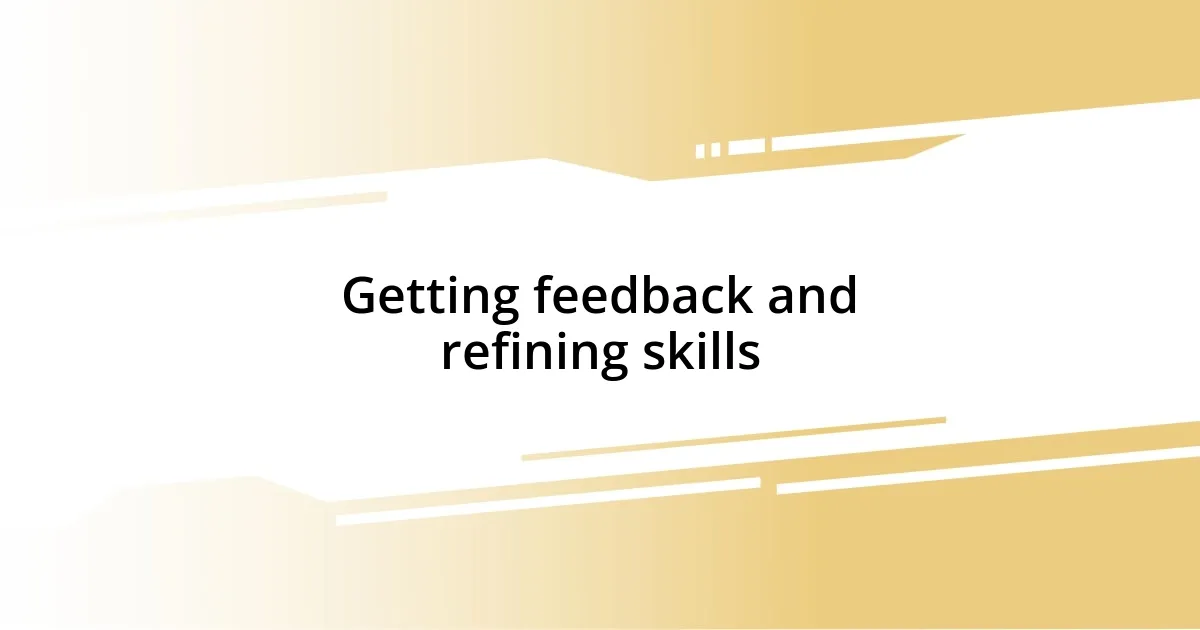
Getting feedback and refining skills
Receiving feedback has been pivotal in honing my on-air skills. I remember the first time a colleague pointed out my tendency to rush through my segments. At first, I felt defensive, but once I took a step back, I realized they were right. Slowing down not only improved my clarity but also allowed listeners to absorb the content better. Have you ever received feedback that initially stung but ultimately benefited you?
Through the years, I’ve actively sought opinions from peers and even trusted listeners. One memorable moment was during a feedback session where someone remarked how my tone sometimes shifted dramatically between segments. It was enlightening to hear that my enthusiasm, while genuine, could come off as inconsistent. I took that advice to heart, practicing a more stable tone that evoked sincerity without the whiplash. Isn’t it fascinating how small adjustments can make such a significant impact?
As I refined my skills, I also learned the importance of self-reflection. After a show, I’d often take a quiet moment to analyze what felt right and what didn’t. Once, I felt particularly energized during a segment about a new music release. Still, upon review, I noticed I cut off a guest’s comment too soon. Recognizing that helped me understand that great dialogue involves active listening. How important is it, after all, to create a collaborative experience on air?



